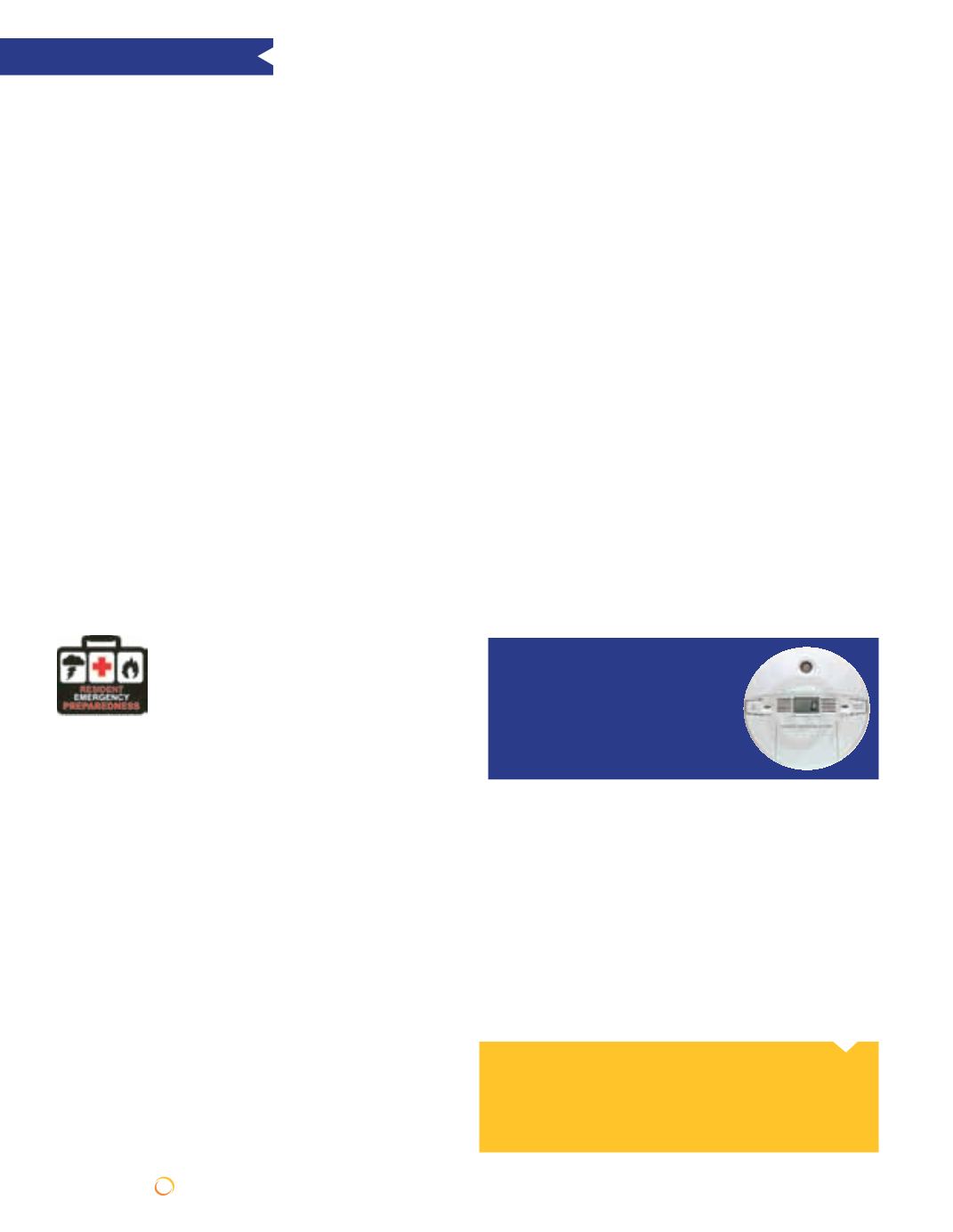
12 | SUNRAYS JANUARY 2014
ONLINE:
SCTXCA.ORG
Carbon monoxide is a colorless, odorless gas
produced by burning fuel; therefore, any fuel-
burning appliance in your home is a potential
source. People exposed to harmful levels of the
gas often show symptoms similar to flu-like
illnesses, including dizziness, fatigue, headaches, irregular
breathing and nausea. Another sign is skin redness. Exposure
can be fatal. If you suspect carbon monoxide exposure, make
sure everyone leaves the house immediately, and leave the
door open. After leaving the house, call 911 from a friend’s or
neighbor’s house, or on your cell phone.
Important things to know:
• Some of our houses were built with smoke detectors and carbon
monoxide/smoke detectors. It is necessary to make sure your
smoke detectors and carbon monoxide detectors are work-
ing—they have a push button and should be tested regularly.
The U.S. Consumer Product Safety Commission recommends
monthly checks. Most of our detectors are hard wired to the
house current; they do have backup batteries that should be
changed yearly (when the time changes fromdaylight savings).
There should be a carbon monoxide/smoke detector outside
each bedroomand a smoke detector in each bedroomand other
living areas (but not in the kitchen, laundry room or garage).
• Although they don’t appear to be doing anything, detectors do
wear out. They should be replaced every five to seven years.
•Have your home heating systemand other natural gas equip-
ment checked annually by a qualified professional.
• Do not operate charcoal grills or gasoline-powered motors
(automobiles or generators) in enclosed spaces (i.e. garage,
home).
• Make sure your car’s motor is off before shutting the garage
door. Car engines are a lot quieter these days and as we get
older, it is easier for us to leave the car running in a closed
garage.
• If you use a fireplace, make sure there is adequate ventila-
tion.
For more information, see the U.S. Consumer Product Safe-
ty Commission’s article on its website,
/
cpscpub/pubs/464.pdf.
CA NEWS
Carbon Monoxide Safety
Submitted by Ron Thompson, Emergency Management Committee
CPR/AED/FIRST AID CLASSES
CPR/AED/First Aid classes are taught regularly
in Sun City Texas. For information, contact
Barbara Akers at
.
Happy New Year! We will continue to
enjoy the holiday decorations until Janu-
ary 15, which is the deadline for taking
down decorations.
If you are changing the outside appear-
ance of your residence, you will need
approval by way of an application sub-
mitted to the Modifications Committee.
There are some exceptions to this gen-
eral rule, which are listed in the “No
Paperwork” table in the Design Guide-
lines. To locate this document online,
go to
and log on with
your Member ID and password. Choose
“Site Index” at the top of the page, then,
under “D,” choose Design Guidelines for
the most recent version.
If the change you are contemplating is
not on the “No Paperwork” list, you will
need to submit a Form B-2 if it is a paint
color you are changing, or a FormB-1 for
any other modification. Remember, even
if an application isn’t required, there are
guidelines noted beside each item that
still need to be followed.
Both forms are located online, where
they can be filled in and printed. When
you bring them to the Community Stan-
dards Office, the staff will make sure all
the required information is submitted.
By allowing us to review your applica-
tion with you prior to submission to the
Modifications Committee, it is more
likely the necessary information will
be included and a successful outcome
will be achieved.
This year, the Modifications Commit-
tee will meet on the first and third
Thursdays of each month in the Andice
Room at Cowan Creek except January.
In January, the meetings will be on the
second and fourth Thursday. If you have
submitted the application by the Friday
prior to the meeting, we guarantee it
will be reviewed by the Committee. You
can submit an application at any time;
however, if it is received after noon on
the Friday prior to the next meeting, we
can’t guarantee the application will be
reviewed at that meeting.
The permit, signifying approval of the
project, need only be posted while the
work is ongoing. Upon completion of the
project, you can dispose of the permit
as you wish. CA staff will inspect the
project about six to eight weeks after
approval.
Ginny Wagner can be reached at
512-948-7462 or email
Bits of Info from Ginny’s Desk
Submitted by Ginny Wagner, Community Standards Supervisor
CARBON MONOXIDE
DETECTORS
It is recommended that you
replace your carbon monox-
ide detectors every 5-7 years.


